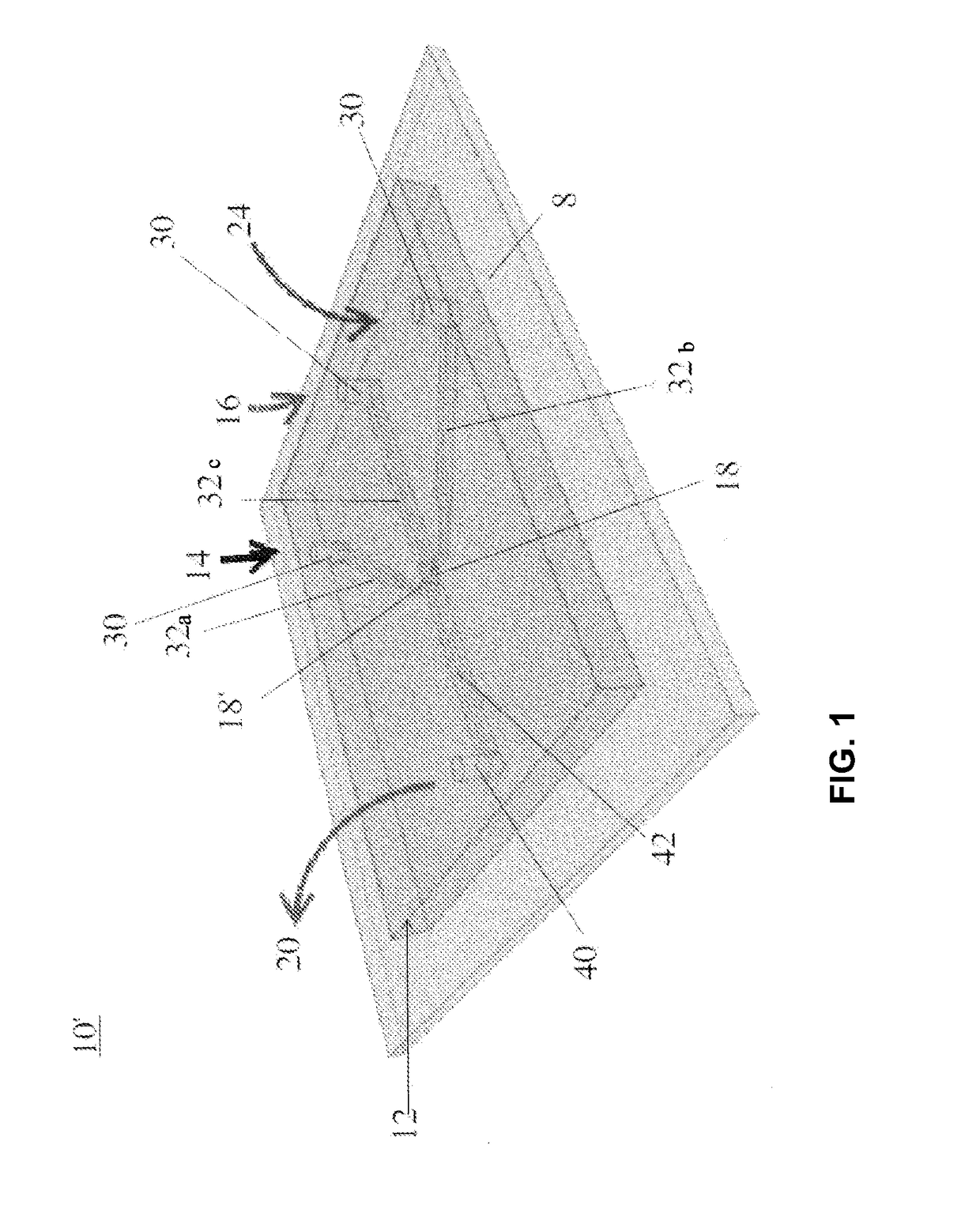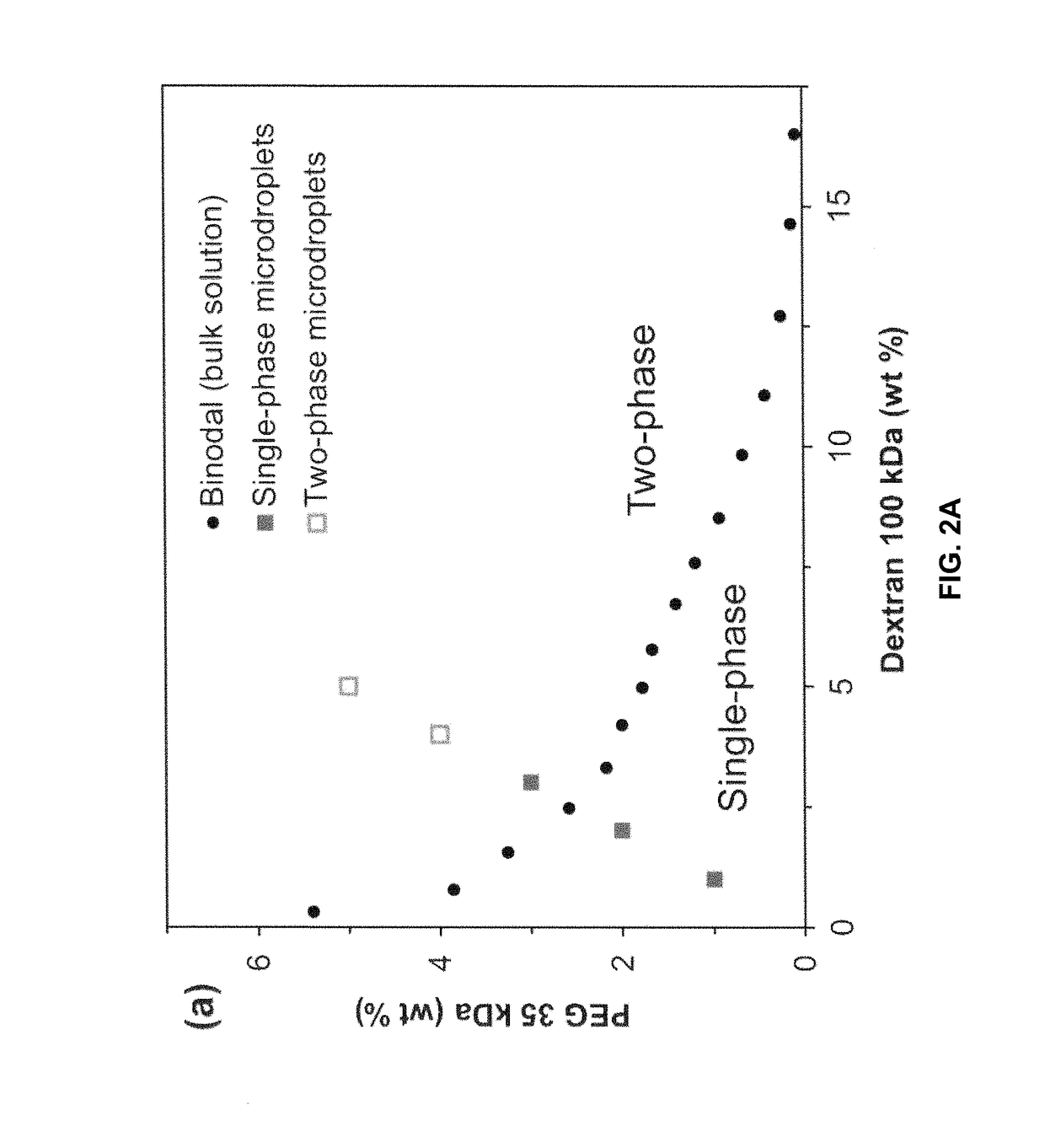Reversible, on-demand generation of aqueous two-phase microdroplets
- Summary
- Abstract
- Description
- Claims
- Application Information
AI Technical Summary
Benefits of technology
Problems solved by technology
Method used
Image
Examples
example 1
General Methods
[0068]An example of a microfluidic device is shown in FIG. 1. The microfluidic device 10′ is composed of poly(dimethylsiloxane) (PDMS) 12 bonded to a PDMS-coated glass cover slip 8, and was fabricated as described [Jung (2010a); Jung et al. (2010b) Lab Chip 10:3373-3376]. To allow for droplet fusion, two opposing aqueous side-channels 32a and 32b (1 μm×1 μm, inputs 14 and 24, respectively, at junctions 18′, 18, respectively) connect to either side of a central oil channel 32c of larger dimensions (14.6 μm wide×18 μm high, input 16). Entry ports for the channels are identified as 30, and exit port is designated as 40 (with exiting two-phase microdroplets designated as 20). The generation and fusion of droplets was obtained by applying pressure pulses to the side-channels; the abrupt change in channel height caused droplet formation to occur by virtue of shape-induced shear when the backing pressure exceeded the capillary pressure of the 1 μm×1 μm side-channels (124-131...
example 2
Generation of Single-Phase and Two-Phase Microdroplets
[0069]A bulk phase diagram for aqueous mixtures of PEG 35 kDa and dextran 100 kDa was constructed using cloud point titration (FIG. 2A, circular data points) [Liu (2012); Albertsson (1986)]. Dextran solutions were prepared in 10 mL test tubes with concentrations ranging from 0-20 wt %, and a stock solution of 10 or 20 wt % PEG was added dropwise until each solution became turbid upon shaking. The critical concentrations of PEG and dextran compose the binodal line, above which phase separation occurs and below which a single-phase mixture results.
[0070]To obtain single-phase and two-phase droplets in the oil microchannel, and using the binodal curve as a guideline, separate PEG and dextran solutions were inserted into their respective side-channels, and their concentrations were varied from 1-5 wt % to cover both sides of the binodal. A pressure pulse was initialized in both side-channels to actuate a PEG drop and a dextran drop i...
example 3
Evaporation-Induced Phase Transitions
[0074]By the generation of static single-phase and two-phase droplets, the phase transitions occurring over time were observed using passive evaporation—which causes polymer concentrations to gradually increase until they cross the binodal line and phase separate [Santesson, (2004); Long (2005); Song (2012)].
[0075]For example a droplet with a 6 μm diameter has a surface area to volume ratio of 1 μm−1. In general, evaporation is enabled by the small amounts of water molecules that are able to diffuse from the microdroplets into the oil, where the maximum possible concentration of water depends on the type of oil used (≈0.3 volume % in soybean oil) [He et al. (2004) Anal. Chem, 76:1222-1227]. The permeability of PDMS allows for the subsequent transport of the water vapor through the walls of the device due to an osmotic pressure difference [Merkel et al. (2000) J. Polym. Sci., Part B: Polym. Phys, 38:415-434].
[0076]For the evaporation experiments, ...
PUM
| Property | Measurement | Unit |
|---|---|---|
| diameter | aaaaa | aaaaa |
| diameter | aaaaa | aaaaa |
| diameter | aaaaa | aaaaa |
Abstract
Description
Claims
Application Information
 Login to View More
Login to View More - R&D
- Intellectual Property
- Life Sciences
- Materials
- Tech Scout
- Unparalleled Data Quality
- Higher Quality Content
- 60% Fewer Hallucinations
Browse by: Latest US Patents, China's latest patents, Technical Efficacy Thesaurus, Application Domain, Technology Topic, Popular Technical Reports.
© 2025 PatSnap. All rights reserved.Legal|Privacy policy|Modern Slavery Act Transparency Statement|Sitemap|About US| Contact US: help@patsnap.com



